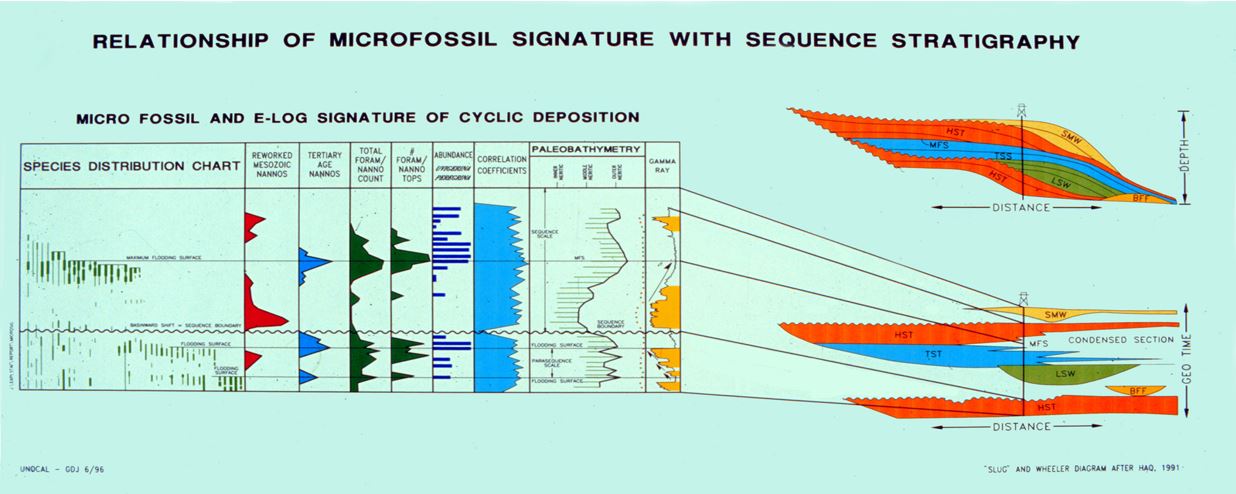Table of Contents
Paleoenvironments and Sequence Biostratigraphy
The determination of paleoenvironments from fossils is important for sequence biostratigraphy (see separate section). Rather than identifying specific, individual paleoenvironments for rock intervals, in sequence biostratigraphy trends are more important – particularly with respect to shallowing- or deepening-upwards depositional sequences. Such trends can be very important in distinguishing between different types of systems tracts.

Examining patterns and trends in biostratigraphic data sets enables the identification of sequence surfaces and systems tracts in a typical 3rd-order sequence cycle. This recognition relies on the ability to determine paleoenvironments and their changes (trends) in response to sea-level rise and fall.
A simple, but common measurement to determine relative paleo water depth is the ratio of planktonic organisms (surface or near-surface dwellers) to benthonic organisms (substrate dwellers) – specifically Foraminifera. A typical whole foraminiferal assemblage will comprise both types of foram but in varying proportions depending mainly on the prevailing water depth:
0-5% planktonics (inner shelf)
5-30% planktonics (middle shelf)
30-50% planktonics (outer shelf)
50-75% planktonics (upper bathyal)
75%+ planktonics (middle bathyal down to CCCD)
However, it should be noted that proportions may vary outside of these ranges due to other local factors. In addition to the proportion of planktonic foraminifera in an overall assemblage, the “type” of planktonic foram can also be a useful supporting indicator of relative water depth. There are a large variety of shell shapes to planktonic foraminifera, however, most forms can broadly be divided into “keeled” and “non-keeled” forms, depending on the presence or absence of varying strengths of peripheral ridges or “keels”. It is believed that “keeled” forms can live at great water depths as part of the animal’s reproductive cycle, perhaps as deep as 4000 metres or even more. Consequently, a fossil assemblage comprising significant numbers of “keeled” types is likely to have been deposited under relatively deep (at least upper bathyal) conditions. Forms which also significantly thicken their shell walls are also thought likely to be potential deep-water dwellers.

Different types of planktonic forams (keeled or non-keeled) reflect differences in relative water depth.
Planktonic foram assemblages in deeper, more oceanic waters are also likely to be dominated by forms who co-exist with algal symbionts allowing them to exist in waters low in other nutrients (eutrophic waters). Determining the fossil foram’s morphological characteristics as evidence of such relationships is, however, difficult.
By measuring trends in paleo water-depth by plotting the planktonic : benthonic foram ratios in a number of samples, an overall shallowing- or deepening-upwards depositional trend can be established.
Like the planktonic foraminifera, benthonic forams are also very useful paleoenvironmental indicators and changes in the character of these assemblages can also help to identify depositional trends.
There is an enormous variety of benthonic foraminifera and there have been many studies which have concentrated on the paleoenvironmental aspects of this group. Although far from exhaustive, the following general statements can be made concerning benthonic foram paleoenvironments:
- The subgroup known collectively as “larger foraminifera” are indicative of warm, shallow (inner shelf or photic zone), clear, tropical waters
- Agglutinated forams predominate in marginal-marine settings (and brackish conditions) and in deep waters below the CCCD
- Agglutinated forams also predominate at all paleodepths where there is significantly reduced dissolved oxygen in the bottom waters or a “stratified” water column
- “Porcellanous” taxa (Miliolids etc.) are ubiquitous but when common can also indicate marginal marine, lagoonal, and shallow hypersaline conditions
- Most families of benthonic forams are shelf and slope dwellers, some species can be shelf- or slope-restricted
- Some families of benthonic forams have changed their paleoenvironmental preference over time e.g. Nodosariids were shallower dwellers (primarily shelf) in the Mesozoic than they are now (primarily bathyal)
- Variation even within a single species can be linked to depth adaptations.
Like planktonic foraminifera, trends as identified by changes in the composition in the benthonic foraminiferal assemblages can be useful to plot trends in paleodepth which in turn helps identify systems tract components.
